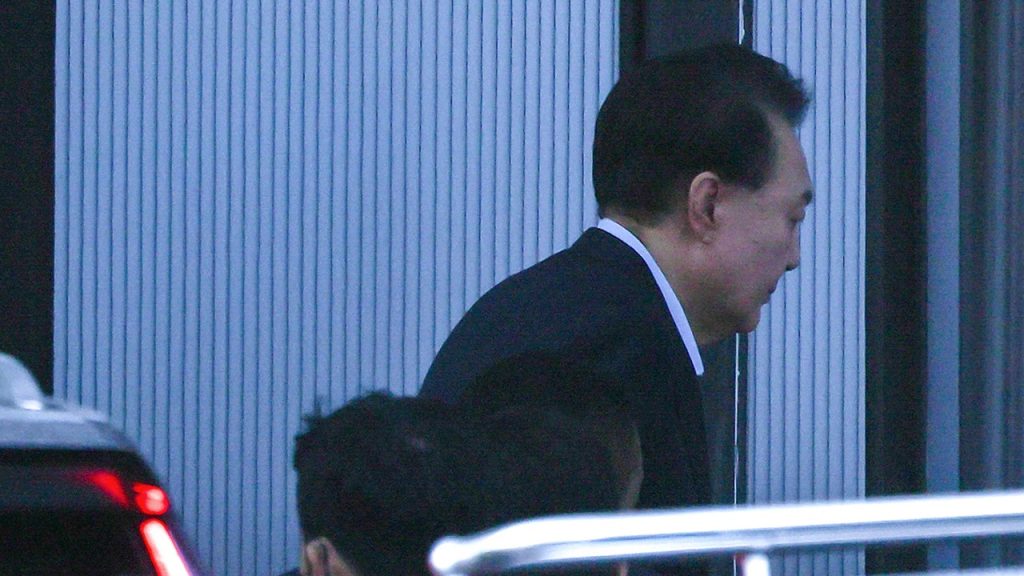The political landscape of South Korea experienced a dramatic upheaval as impeached President Yoon Suk Yeol was detained by law enforcement for questioning regarding his short-lived declaration of martial law the previous month. The detention followed a tense standoff and a previously unsuccessful attempt to apprehend Yoon, highlighting the deep divisions and escalating tensions within the country. Yoon, while asserting the illegality of the investigation, stated his cooperation was aimed at preventing violence and bloodshed, referencing the Corruption Investigation Office for High-Ranking Officials (CIO) as the intended location for his appearance. The scene surrounding Yoon’s compound was a stark tableau of the nation’s polarized state, with throngs of both supporters and opponents gathered amidst a heavy deployment of approximately 3,000 law enforcement personnel. The authorities, following the detention, had a 48-hour window to secure a warrant for Yoon’s formal arrest, adding another layer of complexity to the unfolding political drama. The search warrant, according to Reuters, labelled Yoon as the “ringleader of insurrection,” a stark indictment of his actions.
The backdrop to this dramatic detention was Yoon’s declaration of martial law on December 3rd, a move he justified as necessary to eradicate “anti-state” forces. He further accused the parliament of harboring sympathies for North Korea, a highly charged allegation that further inflamed the already tense political climate. The martial law declaration was met with swift and decisive opposition, notably from the parliament’s speaker and even the leader of Yoon’s own party. This broad-based resistance culminated in Yoon’s suspension from office on December 14th following a decisive 204-85 vote in parliament, marking a significant turning point in the ongoing political crisis. The subsequent lifting of martial law by Acting President Choi Sang-mok, emphasizing the need to avoid conflict between state agencies, sought to de-escalate the tension and restore a semblance of order. However, the underlying tensions remained palpable, evident in Choi’s stern warning to hold those responsible for any further “unfortunate events.”
The initial attempt to detain Yoon on January 3rd had devolved into a protracted six-hour standoff between military guards and the president’s security detail, ultimately failing to secure his apprehension. The CIO expressed “serious regret” over Yoon’s non-compliance with legal processes, further underscoring the breakdown in communication and cooperation between the involved parties. Following this unsuccessful attempt, Yoon remained ensconced within his compound, surrounded by his security team, creating a logistical and legal challenge for investigators seeking to enforce the law. The stand-off underscored the difficulties authorities faced in executing the arrest warrant, compounded by Yoon’s legal counsel’s insistence that such action was prohibited under laws protecting locations potentially linked to military secrets.
The legal wrangling surrounding Yoon’s detention added another layer of complexity to the already tense situation. Yoon’s legal team contested the legality of the investigation and the subsequent warrants, characterizing them as part of a concerted effort to publicly humiliate the embattled leader. This legal challenge further highlighted the fractured state of the South Korean political system, with opposing legal interpretations and procedures contributing to the overall sense of uncertainty and instability. The warrant for Yoon’s arrest, issued on December 31st following his failure to appear for questioning regarding the martial law declaration, marked a critical escalation in the legal proceedings against him. The issuance of the warrant further deepened the political crisis, setting the stage for the subsequent detention and ongoing legal battles.
The unfolding events surrounding Yoon Suk Yeol’s impeachment, martial law declaration, the failed arrest attempt, and the eventual detention paint a picture of a nation grappling with profound political divisions. The standoff between the executive branch and the legislature, the mobilization of law enforcement, and the vocal public protests reflect the deep-seated tensions and the high stakes involved. Yoon’s actions, viewed by his opponents as a dangerous overreach of power, sparked a rapid and decisive response from the legislature and judiciary. The subsequent legal maneuvering and the challenges encountered in executing the arrest warrant further highlighted the fragility of the rule of law amidst such a volatile political climate.
The case of Yoon Suk Yeol serves as a stark reminder of the delicate balance of power within democratic systems and the potential for instability when these balances are disrupted. The ongoing legal proceedings and the intense public scrutiny surrounding the case will undoubtedly shape the future political landscape of South Korea. The ramifications of this political crisis extend beyond the immediate legal battles, raising fundamental questions about the country’s governance, the relationship between the different branches of government, and the role of the military in political affairs. The ultimate resolution of this crisis will be a defining moment for South Korea, testing the resilience of its democratic institutions and its ability to navigate complex political challenges.

